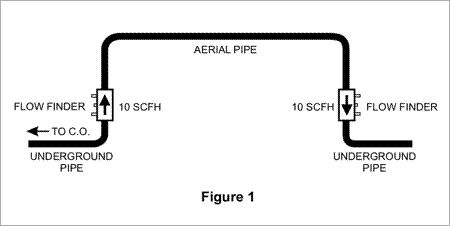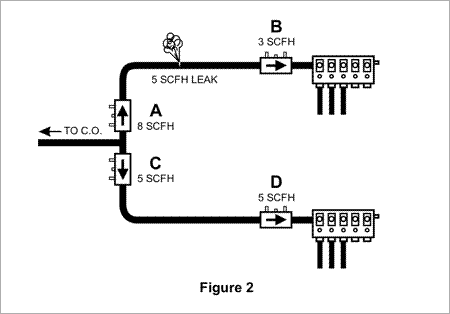Flow Finder Uses
About Air Flow Restriction
Flow Finder Engineering Symbols
Identifying Bad Flow TDs
Checking FTD Accuracy
Choosing Flow Finder Ranges
Flow Finders/Pipe Purification
Flow Finders & High Valves
Flow Finder vs. Portable Flow Rater
Miscellaneous Topics
Flow Gauge Conversions
Using Flow Finders on Route that Does Not Have Flow Transducers
Concerning Pressure Drop

Article #7: Flow Finders/Pipe Purification
August 14, 2006Problem 1: An air pipe goes aerial for almost half a mile before it reenters the underground. A squirrel problem exits in the area (damn varmints!), and a leak is suspected in the aerial section. How do you verify that there is a leak?
Solution: Installing Flow Finders where the air pipe exists and reenters the underground (see Figure 1) will allow you to measure air flow in Standard Cubic Feet per Hour (SFCH). If the flow at these two locations are equal, a leak does not exist in the aerial air pipe. In addition, with this installation the flows can be verified any time a leak is suspected in the air pipe.

Problem 2: A leak is suspected in an underground air pipe where the pipe T's. How can you determine if there is a leak or no leak in this area?
Solution: Two of the recommended locations for installing Flow Finders are at air pipe T's and manifolds (Figure 2). If the flow at each of the legs is equal to the flow at the air pipe manifold, there are no leaks. For example, Flow Finder A should equal Flow Finder B, and Flow Finder C should equal Flow Finder D. If the flow readings don't match up (as in Flow Finders A and B), you've got a leak in that section of air pipe.

If you have any questions about how the Flow Finders can be used in your area, give us a call at (800) 247-8255. We'd appreciate hearing from you. And if you're already using Flow Finders and the Flow Gauge for leak locating in various situations, we'd like to hear about them so we can share your findings with our readers.